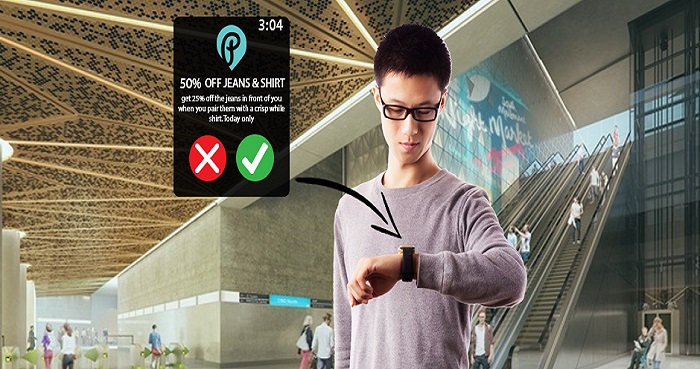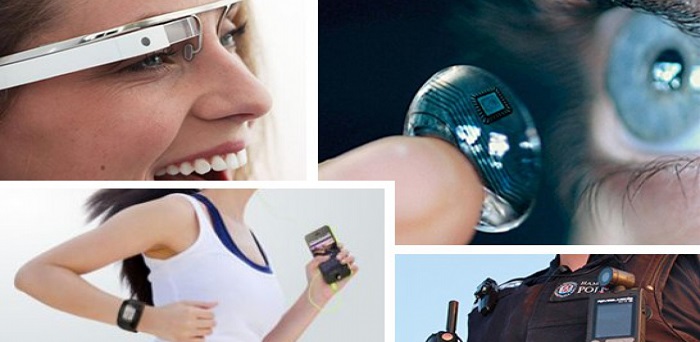Picture this, it’s a Monday, the traffic is about to get to you, you are in a three-piece suit, there are no cabs available in your vicinity and you haven’t even left for work yet. The 9 am meeting is very important and the client is considered extremely valuable. This is what will happen, your smartphone receives the update about the availability of cabs in your area, your smartwatch gets a notification to suggest you to take your bicycle out, as you haven’t even burnt enough calories for the day and you are yet to achieve your fitness goal, while your smart glasses give you a turn by turn directions via augmented reality to ensure you reach your destination before time. This is not the future, it is possible today. Wearables are here to stay and be a part of an individual’s day-to-day life, let’s look at how this will change the retail experience.
There are mainly three components to the wearables tech. Tracking, notifying and guiding. Let’s begin with:

1) Tracking
Tracking is the first and foremost component in the journey of enhancing the retail experience, not only for customers but also for retailers. When a customer enters a retail store and a wearable such as the Apple watch or a Fitbit/Garmin can notify the store’s backend team of the customer’s presence in the store. The team will instantly be able to refer to the items that the customer generally picks up during their previous visits. For an employee sitting at the cash counter, a wearable such as smart glasses by Sony, Epson Moverio or a Vuzix Blade with an embedded can track the daily interactions with the customers. This is very useful in the event that the employee is subjected to some kind of a mishap, misses out on transactional details or simply needs instant access to a seasoned customers loyalty points.
In the product area the smart glasses can be equally useful as well, an extension of which would be the smart basket, with an embedded weighing scale and barcode scanner, can keep a tab of the objects being added the cart. In the movie, Valerian and the city of a thousand planets the lead character is led into an open ground on an unknown planet, where he is asked to put on a pair of glasses that transcends the user to another portal that happens to be a busy, flea market that is augmented via the glasses on the open ground. We are yet to gain access to parallel dimensions but wearable technologies with virtual reality capabilities can transport the user to a category-specific virtual outlet where they the customer can have a brick and mortar experience of a retail store without the hassles of standing in a long endless queue or dealing with an unpleasant sales executive.
![]()
2) Notifying
Once the store has received a notification of the customer’s presence, the next step would be determining which items the customer generally picks up at the store by the back end team, the AI server at the mall gets notified, simultaneously a notification is sent to one of the wearables or smartphone of the customer acknowledging their presence and welcoming them. On the front desk where the employee is wearing the smart glasses, showcases instantly the loyalty and reward points of the customer while ensuring what would be the discount the customer would be eligible for. The smart glasses are also extremely useful in the event of an act of violence such as burglary is conducted. The glasses will augment messages that will ask the user to stay calm while notifying authorities that can take immediate action. Inside the retail outlet, the crate in which the user is carrying the items that they have picked up will determine the weight, cost, product and discount to the connected systems, for a quick exit.
3) Guiding
Wearables that have a screen to display the planned action, audio capabilities that will provide instructions or augmented reality-based software that based on the tracking and notifying shall compute to eventually provide individually tailored solutions that will keep the data relevant. It will guide the user to either quickly pick up a pre-stacked basket of products based on the consumers purchase history, suggest the best possible products through the smart watch’s voice capabilities or if the place has a smart basket the customer can simply walk out of the retail shop while the wearables such as the Apple watch or a Fitbit/Garmin will automatically make the payment at the exit gate. For employees wearing the smart glasses happens to detect any anomalies in the customer behavior it can alert the security upfront or intimate the legal authorities to intervene and diffuse the situation.

Wearable technology in the retail world is evolving and is gradually arriving at the point where the journey from problem to arriving at a solution will be seamless and effective. We are living in a digital age with multiple possibilities and exciting opportunities that will enhance each and every interaction we have with the world.
(This article has been contributed by Xenium Digital CEO & managing director Parveez Nasyam and AnimationXpress.com does not necessarily subscribe to these views).
